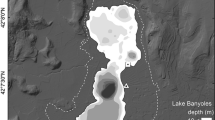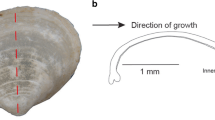Abstract
A fingernail clam (Sphaerium simile, Sphaeriidae) from Science Lake, a small watershed located in Allegany State Park, New York, USA and a zebra mussel (Dreissena polymorpha, Dreissenidae) from Keuka Lake, New York, the third largest Finger Lake of central New York, were selected to evaluate the applicability of using δ18O(CaCO3) and δ13O(CaCO3) values for sub-weekly climate records. Seasonal variation in δ18O(CaCO3) values was compared with predicted equilibrium values to test the hypothesis that lacustrine molluscs produce shell aragonite according to environmental variables. For the purpose of comparison, aragonite temperature-fractionation equations determined by Grossman& Ku (1986) and Patterson et al. (1993) were used. Sphaerium simile appears to produce δ18O(CaCO3) values predicted by Patterson et al. (1993), while Dreissena polymorpha produces δ18O(CaCO3) values in agreement with Grossman & Ku (1986). We attribute the difference to family-specific temperature-fractionation relationships. Because both types of mollusc record climate variables with a high degree of integrity, they should each serve as excellent paleoclimate proxies.
The fingernail clam collected from a small watershed exhibits higher variation about the seasonal pattern than did the zebra mussel collected from a large watershed. This is attributed to the increased sensitivity of the small watershed to storm perturbation. Analysis of fossil molluscs from such watersheds might be useful in discerning paleo-storminess.
Similar content being viewed by others
References
Atekwana, E. A. & R. V. Krishnamurthy, 1998. Seasonal variations of dissolved inorganic carbon and δ13C of surface waters: application of a modified gas evolution technique. J. Hydrol. 205: 265–278.
Beck, W. J., J. Récy, F. Taylor, R. L. Edwards & G. Cabioch, 1997. Abrupt changes in early Holocene tropical sea surface temperature derived from coral records. Science 385: 705–707.
Campana, S. E., 1999. Chemistry and composition of fish otoliths: pathways, mechanisms and applications. Mar. Ecol. Prog. Ser. 188: 263–297.
Casteel, R. W., 1976. Fish Remains in Archeology and Paleoenvironmental Studies. Academic Press, New York.
Dettman, D. L. & K. C. Lohmann, 1993. Seasonal change in Paleogene surface water δ18O: Fresh-water bivalves of western North America. In Swart, P., K. C Lohmann, J. McKenzie & S. Savin (eds), Amer. Geophys. Union Monogr. Continental Climate Change from Isotopic Records. 78: 153–163.
Dettman, D. L. & K. C. Lohmann, 1995. Microsampling carbonates for stable isotope and minor element analysis; physical separation of samples on a 20 micrometer scale. J. Sed. Res. A. 65: 566–569.
Dettman, D. L., A. K. Reische & K. C. Lohmann, 1999. Controls on the stable isotope composition of seasonal growth bands in aragonitic fresh-water bivalves (Unionidae). Geochim. et Cosmochim. Acta 63: 1049–1057.
Dingman, S. L., 1972. Equilibrium temperatures of water surfaces as related to air temperature and solar radiation. Wat. Resour. Res. 8: 42–49.
Edinger, J. E., D. W. Duttweiler & J. C. Geyer, 1968. The response of water temperatures to meteorological conditions. Wat. Resour. Res. 4: 1137–1143.
Fastovsky, D. E., M. E. Arthur, N. H. Strater & A. Foss, 1993. Freshwater bivalves (Unionidae), disequilibrium isotopic fractionation, and temperatures. Palaios 8: 602–608.
Friedman, I. & J. R. O'Neil, 1977. Compilation of stable isotope fractionation factors of geochemical interest. In Friedman, I. & J. R. O'Neil (eds), Data of Geochemistry. U.S. Geol. Surv. Washington, DC: KK1-KK12.
Grossman, E. L. & T.-L. Ku, 1986. Oxygen and carbon isotope fractionation in biogenic aragonite: temperature effects. Chem. Geol. 59: 59–74.
Hass, H. C., 1996. Northern Europe climate variations during late Holocene: evidence from marine Skagerrak. Palaeogeog. Palaeoclim. Palaeoecol. 123: 121–145.
Jones, D. S., M. A. Arthur & D. J. Allard, 1989. Sclerochronological records of temperature and growth from shells of Mercenaria mercenaria from Narragansett Bay, Rhode Island. Mar. Biol.102: 225–234.
Jones, D. S. & I. R. Quitmyer, 1996. Marking time with bivalve shells: Oxygen isotopes and season of annual increment formation. Palaios 11: 340–346.
Kalish, J. M., 1991. 13C and 18O isotopic disequilibria in fish otoliths: metabolic and kinetic effects. Mar. Ecol. Prog. Ser. 75: 191–203.
Kim, S. & J. R. O'Neil, 1997. Equilibrium and nonequilibrium oxygen isotope effects in synthetic carbonates. Geochim. et Cosmochim. Acta 61: 3461–3475.
Klein, R. T., K. C. Lohmann & C. W. Thayer, 1996. Bivalve skeletons record sea-surface temperature and δ18O via Mg/Ca and 18O/16O ratios. Geology 24: 415–418.
Krantz, D. E., D. F. Williams & D. S. Jones, 1987. Ecological and paleoenvironmental information using stable isotope profiles from living and fossil mollusks. Palaeogeog. Palaeoclim. Palaeoecol. 58: 249–266.
Lamb, H. H., 1995. Climate history and the modern world, 2nd ed., London, Methuen, 433 pp.
Leder, J. J., P. K. Swart, A. M. Szmant & R. E. Dodge, 1996. The origin of variations in the isotopic record of scleractinian corals: I. Oxygen. Geochim. et Cosmochim. Acta 15: 2857–2870.
Linsley, B. K., R. B. Dunbar, G. M. Wellington & D. A. Mucciarone, 1994. A coral-based reconstruction of Intertropical Convergence Zone over Central America since 1707. J. Geophys. Res. 99: 9977–9994.
Livingstone, D. M. & A. F. Lotter, 1998. The relationship between air and water temperatures in lakes of the Swiss Plateau: A case study with palaeolimnological implications. J. Paleolim. 19: 181–198.
McCombie, A. M., 1959. Some relations between air temperatures and the surface water temperature of lakes. Limnol. Oceanogr. 41: 252–258.
McConnaughey, T., 1989a. 13C and 18O isotopic disequilibrium in biological carbonates: I. Patterns. Geochim. et Cosmochim. Acta 53: 151–162.
McConnaughey, T., 1989b. 13C and 18O isotopic disequilibrium in biological carbonates: II. In vitro simulation of kinetic isotope effects. Geochim. et Cosmochim. Acta 53: 163–171.
Michel, R. L. & T. F. Kraemer, 1995. Use of isotopic data to estimate water residence times of the Finger Lakes, New York. J. Hyrol. 164: 1–18.
Neumann D., J. Borcherding & B. Jantz, 1993. Growth and seasonal reproduction of Dreissena polymorpha in the Rhine River and adjacent waters. In Nalepa, T. F. & D. W. Schloesser (eds), Zebra Mussels: Biology, Impacts, and Control. Lewis Publishers, 95–110.
Patterson, W. P., 1998. North American continental seasonality during the last millennium: high-resolution analysis of sagittal otoliths. Palaeogeog. Palaeoclim. Palaeoecol. 138: 271–303.
Patterson, W. P., G. R. Smith & K. C. Lohmann, 1993. Continental paleothermometry and seasonality using the isotopic composition of aragonitic otoliths of freshwater fishes. In Swart, P., K. C Lohmann, J. McKenzie & S. Savin (eds) Amer. Geophys. Union Monogr. Continental Climate Change from Isotopic Records. 78: 191–202.
Rahimpour-Bonab, H., Y. Bone & R. Moussavi-Harami, 1997. Stable isotope aspects of modern molluscs, brachiopods, and marine cements from cool-water carbonates, Lacepede Shelf, South Australia. Geochim. et Cosmochim. Acta. 61: 207–218.
Romaneck, C. S., E. L. Grossman & J. W. Morse, 1992. Carbon isotopic fractionation in synthetic aragonite and calcite: Effects of temperature and precipitation rate. Geochim. et Cosmochim Acta 56: 419–430.
Schwarcz, H. P., Y. Gao, S. Campana, D. Browne, M. Knyf & U. Brand, 1998. Stable carbon isotope variations in otoliths of Atlantic cod (Gadus morhua). Can. J. Fish. Aquat. Sci. 55: 1798–1806.
Smith, G. R. & W. P. Patterson, 1994. Mio-Pliocene seasonality on the Snake River plain: comparison of faunal and oxygen isotopic evidence. Palaeogeog. Palaeoclim. Palaeoecol. 107: 291–302.
Steuber, T., 1996. Stable isotope sclerochronology of rudist bivalves: Growth rates and late Cretaceous seasonality. Geology 24: 315–318
Tanaka, N., C. Monaghan & D. M. Rye, 1986. Contribution of metabolic carbon to mollusc and barnacle shell carbonate. Nature 320: 520–523.
Tarutani, T., R. N. Clayton & T. K. Mayeda, 1969. The effect of polymorphism and magnesium on oxygen isotope fractionation between calcium carbonate and water. Geochim. et Comochim. Acta 33: 987–996.
Tevesz, M. J. S., E. Barrera & S. F. Schwelgien, 1996. Seasonal variation in oxygen isotope composition of two freshwater bivalves: Sphaerium striatinum and Anodonta grandis. J. Great Lakes Res. 22: 906–916.
Urey, H. C., 1947. The thermodynamic properties of isotopic substances. J. Chem. Soc.: 562–581.
Veinott, G. I. & R. J. Cornett, 1996. Identification of annually produced opaque bands in the shell of the freshwater mussel Elliptio complananta using the seasonal cycle of δ18O. Can. J. Fish. Aquat. Sci. 53: 372–379.
von Grafenstein, U., H. Erlernkeuser & P. Trimborn, 1999. Oxygen and carbon isotopes in modern fresh-water ostracod valves: assessing vital offsets and autecological effects of interest for palaeoclimate studies. Palaeogeog. Palaeoclim. Palaeoecol. 148: 133–152.
Webb, M. S., 1974. Surface temperatures of Lake Erie. Wat. Resour. Res. 10:199–210.
Wefer, G. & W. H. Berger, 1991. Isotope paleontology: growth and composition of extant calcareous species. Mar. Geol. 100: 207–248.
Wurster, C. M., W. P. Patterson & M. M. Cheatham, 1999. Advances in computer-based microsampling of biogenic carbonates. Comp. Geosci. 25: 1155–1162.
Xia, J., B. J. Haskell, D. R. Engstrom & E. Ito, 1997. Holocene climate reconstructions from tandem trace-element and stableisotope composition of ostracodes from Coldwater Lake, North Dakota, USA. J. Paleolim. 17: 85–100.
Author information
Authors and Affiliations
Rights and permissions
About this article
Cite this article
Wurster, C.M., Patterson, W.P. Seasonal variation in stable oxygen and carbon isotope values recovered from modern lacustrine freshwater mollusks: paleoclimatological implications for sub-weekly temperature records. Journal of Paleolimnology 26, 205–218 (2001). https://doi.org/10.1023/A:1011194011250
Issue Date:
DOI: https://doi.org/10.1023/A:1011194011250




